Quiet month for Airbus. Boeing reports very strong orders, weak 737 MAX deliveries.

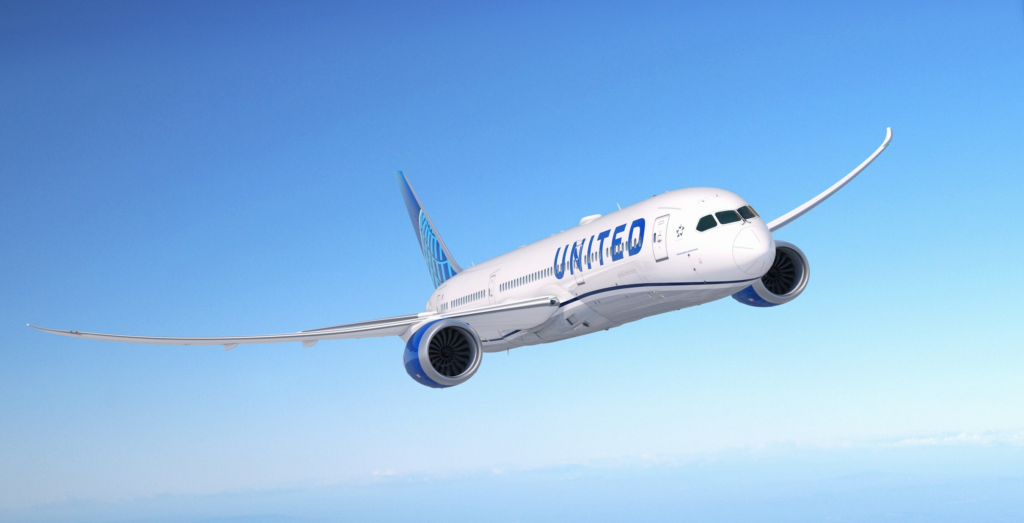
Boeing and Airbus delivered 27 and 55 commercial jets in September 2023, compared to 51 and 53 deliveries, respectively, in the same month last year. Boeing’s September deliveries were affected by a new 737 MAX manufacturing issue discovered in late August. Year-to-date, Boeing and Airbus have delivered 371 and 488 aircraft, compared to 328 and 435, respectively, during the first nine months of 2022. As of September, Boeing and Airbus are 43 and 53 deliveries ahead of last year’s totals to date. In 2022, Airbus won the deliveries crown for the fourth year in a row by delivering 663 aircraft, compared to Boeing’s 480 shipments. In 2021, Boeing and Airbus delivered 340 and 611 aircraft.
Following a more than challenging 2020 due to the COVID-19 pandemic, 2021 and 2022 were recovery years for the two largest commercial plane makers. Another year of recovery for the commercial aircraft manufacturing industry is expected in 2023 despite continued economic and geopolitical challenges. However, Boeing and Airbus still have quite a way to go before deliveries are back to pre-pandemic levels. In 2018, before COVID-19 and the 737 MAX grounding, Boeing delivered 806 jets, a level that will likely not be recaptured before the 2025-26 timeframe. Airbus’ all-time record high of 863 shipments was set in 2019, a level that could be surpassed in 2024 if supply chain challenges ease, but most likely not before 2025. Also, Airbus is expected to retain the deliveries lead for the foreseeable future due to the company’s comfortable backlog lead over its American rival. Prior to 2019, Boeing had out-delivered Airbus every year since 2012.
As indicated above, in September 2023, Boeing delivered 27 jets, including 15 737s (all MAXs), two 777s, and 10 787s. As mentioned above, Boeing’s September deliveries were significantly affected by a 737 MAX manufacturing issue discovered in late August. Boeing and Spirit AeroSystems announced that improperly drilled fastener holes had been discovered in the aft pressure bulkhead on the fuselages of some 737 MAX models. In a press release, Spirit AeroSystems stated, “We believe there will not be a material impact to our delivery range for the year related to this issue.” At the Q2 2023 investor earnings call in July, Boeing announced that “the 737 program is transitioning production to 38 per month.” Since June of last year, the 737 program has been producing aircraft at an official rate of 31 per month. Year-to-date, Boeing has delivered 32 737s per month, on average. At the Q2 earnings call, Boeing reaffirmed its guidance for 400-450 737 MAX deliveries for the year. It is uncertain whether the new 737 MAX defect and rework will affect Boeing’s 2023 guidance. Longer term, Boeing expects to increase production to approximately 50 jets per month in the 2025/26 timeframe. This compares to the pre-crash/pre-pandemic rate of 52 737s per month in 2018. Recently, it was reported that the company is planning to boost production to 52 jets per month by January 2025. The company plans to open a new 737 MAX production line in Everett in the second half of 2024. The new line is in addition to the three lines currently in place in Renton. Boeing ended the second quarter with 228 737 MAX jets in inventory, up three from Q1 2023. Customers in China account for 85 of these aircraft. Boeing expects most of the inventoried jets will be delivered by the end of 2024. The company is still producing 737 NGs, but only has 19 737-800s remaining in backlog.
In August of last year, deliveries of the Boeing 787 Dreamliner were resumed following a suspension of shipments that lasted nearly 16 months. Boeing had suspended Dreamliner deliveries in May 2021 for the second time in less than a year. At the end of June, the 787 production rate was raised for the second time this year and is now four per month. The 787 rate will return to five per month by the end of 2023 (for a total of 70-80 deliveries for the year), followed by further increases before reaching 10 aircraft per month by 2025/26. Boeing ended the first quarter with 85 Dreamliners in inventory, down 10 from Q1 2023. Most of these aircraft will be delivered during 2023 and 2024.
The 747 program closed down production when the last aircraft was delivered to Atlas Air in January this year. The 767 program is currently producing at a rate of three units per month, a mix of KC-46 tankers (based on the 767-2C) and 767-300 freighters. The 777 program is currently pushing out aircraft at a rate of three aircraft per month. Most aircraft in backlog are 777 freighters, with only five 777-300ERs left. The 777 program was expected to get a new addition in late 2023 with the first delivery of the 777X, but in April of last year Boeing announced this will now not happen before 2025. This reflects an updated assessment of the time required to meet certification requirements. Last year, Boeing launched a new 777X-based freighter, thereby expanding its 777X and cargo portfolio. By the 2025/26 timeframe, Boeing expects to be delivering four 777s per month.
In September 2023, Airbus delivered 55 jets, including four A220s, 44 A320s (all NEO), two A330s, and five A350s. The official A320 production rate is 45 aircraft per month, and it has remained at this level since the end of 2021. On average, the company has delivered 43 A320s per month in 2023 (same as the 2022 average). Production is currently being increased and a rate hike can be expected later this year. The A320 program is expected to reach a monthly rate of 65 by late 2024 (pushed back twice now due to supply chain challenges). Also, Airbus is working with its supply chain to increase A320 production to 75 aircraft per month in 2026. The A321XLR flight test program is reportedly progressing well, and entry into service is expected in the second quarter of 2024.
The A220, meanwhile, is being produced at a rate of six aircraft per month, with a monthly production rate of 14 expected by 2025. Airbus is currently planning to launch a stretch version of the A220, which many now refer to as the “A220-500” or even “A221.” Currently, the Pratt & Whitney PW1500G is the only engine option for the A220, and the new variant will most likely come with a second engine option.
The A350 production rate currently averages five per month and was expected to be increased to six by early 2023. However, the rate increase has likely been pushed back to late 2023. Airbus expects to produce nine A350s per month by 2025. The A330 production rate was increased from two aircraft per month to three at the end of 2022, with an increase to four per month expected in 2024.
Turning to the September orders review, Boeing had a very strong month and booked orders from five customers for a total of 224 jets (gross orders) and reported 10 cancellations (three 737 MAXs, three 777Fs and four 787s), resulting in 214 net new orders. The September orders haul was dominated by low-cost giant Ryanair’s order for 150 737 MAX 10 jets plus 150 options, which was announced back in May of this year. The aircraft will be delivered between 2027 and 2033. Also in September, United Airlines announced a large order and booked 50 787-9 Dreamliners, followed by another Dreamliner order from Air Canada for 18 787-10s. Finally, two undisclosed customers booked orders for six Dreamliners, of which four were 787-9s and two, 787-10s. September was obviously a very good month for Boeing’s Dreamliner family of aircraft. Year-to-date, Boeing has accumulated 724 net new orders (848 gross orders), compared to 428 net new orders (542 gross orders) in the first nine months of last year. In 2022, Boeing booked 774 net new orders (935 gross orders), up from 479 net new orders (909 gross orders) in 2021 (before ASC 606 changes). Please note that for comparison reasons, we do not include Boeing’s so-called ASC 606 accounting adjustments in the numbers reported in this article and regard net new orders as gross orders minus cancellations.
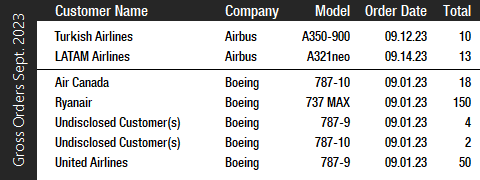
In September, Airbus had a quiet month and booked orders for 23 aircraft from two different customers and reported no cancellations. Turkish Airlines placed an order for 10 A350-900s, while LATAM Airlines Group ordered 13 A321neos. LATAM is Latin America’s leading airline group with presence in Brazil, Chile, Colombia, Ecuador and Peru. Year-to-date, Airbus has accumulated 1,241 net new orders (1,280 gross orders), compared to 637 net new orders (856 gross orders) in the first nine months of 2022. In 2022, Airbus booked 820 net new orders (1,078 gross orders), surpassing both 2021 gross orders and net new orders. In 2022, Airbus won the orders crown for the fourth consecutive year by a fairly slim margin of just 46 aircraft compared to Boeing. In 2021, Airbus booked a total of 771 gross orders and received 264 cancellations, for a total of 507 net new orders.
At the end of September, Airbus reported a backlog of 7,992 jets, of which 7,273, or 91 percent, were A220 and A320ceo/neo family narrowbodies. Last month Airbus reported a backlog of 8,024 jets, setting a new all-time backlog record high, surpassing the old record of 7,967 jets set in June of this year just after the Paris Air Show. By the end of last month, Boeing’s backlog (total unfilled orders before ASC 606 adjustment) was 5,783 aircraft, of which 4,504, or 78 percent, were 737 NG/MAX narrowbody jets. Boeing’s all-time backlog high of 5,964 aircraft was set in August 2018. While well behind Airbus’ backlog, Boeing has increased its orderbook significantly in recent years. The number of Airbus aircraft to be built and delivered represents 9.3 years of shipments at the 2019 production level (the pre-pandemic level), or 12.1 years based on the 2022 total. In comparison, Boeing’s backlog would “only” last 7.2 years at the 2018 level (the most recent “normal” year for Boeing), or 12.0 years based on 2022 deliveries. As of September 30, Boeing’s book-to-bill ratio this year, calculated as net new orders divided by deliveries, is a very strong 1.95, with Airbus coming in even higher at 2.54. This means that Airbus has received 2.5 orders for every aircraft the company has delivered so far this year. In 2022, Boeing’s book-to-bill ratio was a very strong 1.61. Meanwhile, Airbus’ book-to-bill ratio was a solid 1.24.
2023 Forecast
Forecast International’s Platinum Forecast System is a breakthrough in forecasting technology that provides 15-year production forecasts. The author has used the Platinum Forecast System to retrieve the latest delivery forecast data from the Civil Aircraft Forecast product. For 2023, Forecast International’s analysts currently expect Boeing and Airbus to deliver 515 and 706 commercial jets, respectively. Please note that these figures exclude militarized variants of commercial platforms such as Boeing’s P-8 Poseidon maritime patrol aircraft and KC-46 Pegasus tanker and Airbus’ A330 MRTT tanker.
Boeing released its Q2 2023 results in July and reaffirmed the company’s 2023 737 MAX and 787 guidance from November of last year. In November of last year, Boeing announced that it expects to deliver 400-450 737s and 70-80 787s in 2023, which equates to a monthly average of 33-38 for the 737. Boeing will release its third quarter 2023 results on October 25. Airbus released its H1 2023 results in July and reaffirmed the previous guidance for 720 commercial jet deliveries in 2023. Airbus will release third quarter and nine-month 2023 results on November 8.
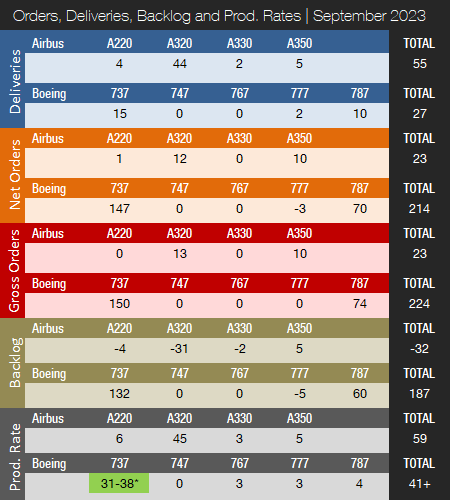
*Boeing is currently transitioning from 31 to 38 737 MAXs per month. The official rate is still 31/month.
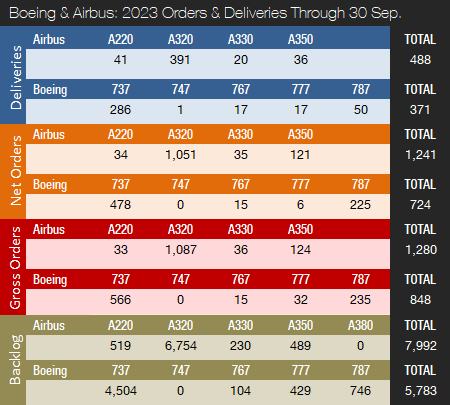
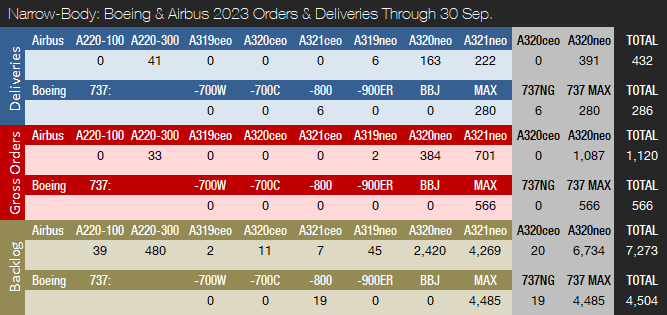
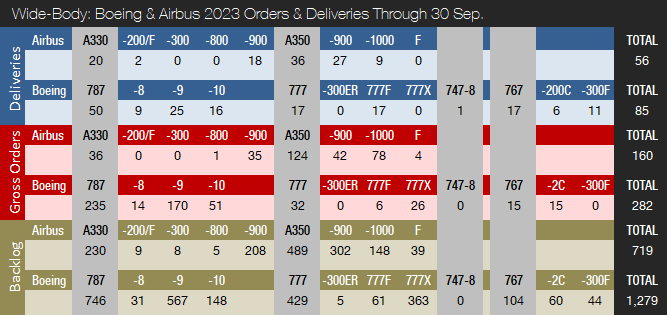
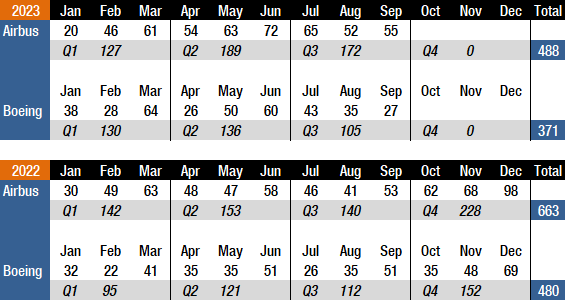
References:
- https://www.forecastinternational.com/platinum.cfm
- http://www.boeing.com/commercial/#/orders-deliveries
- https://www.airbus.com/aircraft/market/orders-deliveries.html
- https://boeing.mediaroom.com/2023-10-03-United-Airlines-Orders-50-More-Boeing-787-Dreamliners
- https://www.latamairlinesgroup.net/corporate-profile
- https://corporate.ryanair.com/news/ryanair-orders-300-boeing-737-max-10-aircraft-worth-40bn/
- https://investors.boeing.com/investors/news/press-release-details/2023/Ryanair-Places-Its-Biggest-Boeing-Order-for-up-to-300-737-MAX-Jets/default.aspx
- https://apnews.com/article/spirit-aerosystems-boeing-737-fuselage-28bceec61cef878005b965a016fa8787
- https://www.spiritaero.com/pages/release/spirit-aerosystems-737-aft-bulkhead-statement/
Kasper Oestergaard is an expert in aerospace & defense market intelligence, fuel efficiency in civil aviation, defense spending and defense programs. Mr. Oestergaard has a Master's Degree in Finance and International Business from the Aarhus School of Business - Aarhus University in Denmark. He has written four aerospace & defense market intelligence books as well as numerous articles and white papers about European aerospace & defense topics.



